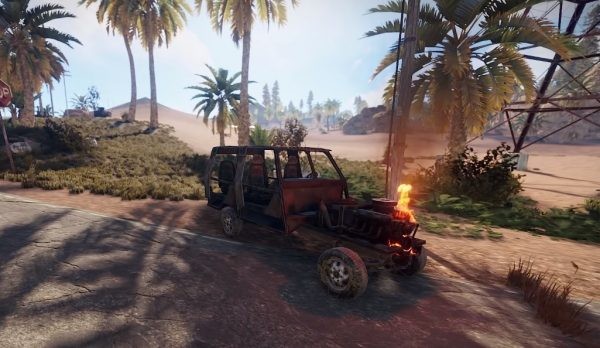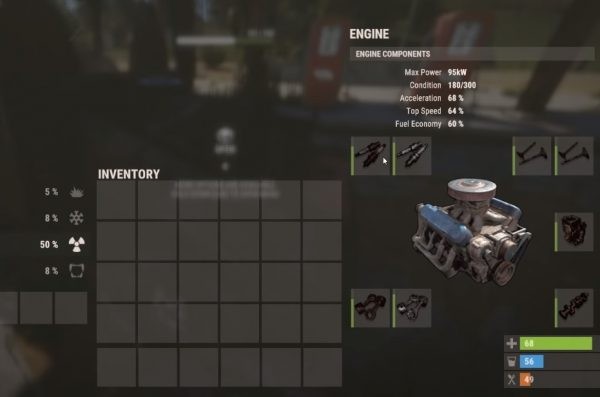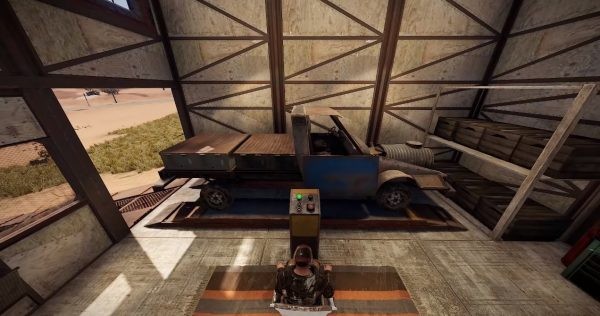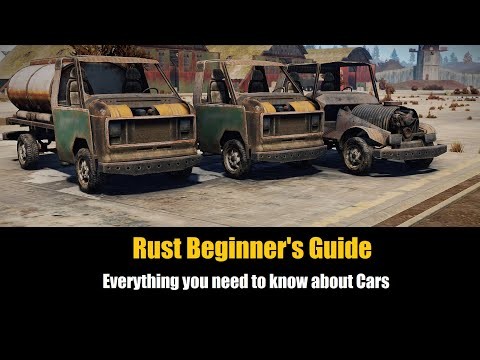Modular Vehicles have revolutionized transportation in Rust, offering players unprecedented customization and mobility. But finding a chassis is just the beginning. To get your ride roaring across the Rust landscape, understanding how to repair and upgrade your car is essential. This guide will walk you through the process of getting those rusty wrecks road-ready, covering everything from finding a vehicle chassis to installing performance-enhancing upgrades.
Locating a Vehicle Chassis in Rust
Your journey to car ownership in Rust starts with finding a vehicle chassis. These aren’t just lying around in pristine condition; you’ll need to scavenge for them. Keep an eye out while traversing the roads of Rust for smoking and sparking wrecks. These visually distinct chassis are your starting point. You’ll typically find them abandoned alongside roads, waiting for a resourceful player to bring them back to life.
Image showing a rusty car chassis in Rust, emitting smoke and sparks, indicating its location and condition.
These chassis often come with pre-attached modules. Consider these a bonus, but be prepared to assess their condition. Modules, like the chassis itself, might be damaged. You’ll need resources like Metal Fragments, High-Quality Metal, and Wood to repair both the chassis and any existing modules. Don’t underestimate the initial repair work needed to simply get the vehicle operational. Even pushing a car requires it to be in a minimal state of repair to avoid further damage. And a word of caution: letting a damaged car roll backwards could lead to some painful consequences for you.
Essential Engine Components for Car Repair in Rust
Once you’ve secured a chassis, the real work begins: repairing the engine. An engine without its parts is just dead weight. You’ll need to source a set of core engine components to bring your modular vehicle to life. These parts aren’t readily available fully assembled; you’ll need to hunt for them. You can acquire these crucial components through several methods:
- Vendors: Certain vendors, like the Air Wolf vendor at the Bandit Camp, sell medium-quality engine components.
- Toolboxes: Keep your eyes peeled for toolboxes scattered around the map. These can contain engine parts, offering a loot-based acquisition method.
- Crafting: For a more reliable source, especially for higher quality parts, crafting is key. You can craft low, medium, and high-quality versions of each component, influencing your vehicle’s performance and longevity.
Before you can craft, you’ll likely need to research engine parts at a research table using scrap. The basic engine components you’ll need to repair a car in Rust are:
- Spark Plug: Essential for ignition.
- Carburetor: Mixes air and fuel for combustion.
- Shift Stick / Crankshaft: Translates piston motion to rotational power. (Note: The original article mentions “shift stick/crankshaft” which might be slightly confusing. In game terms, it’s likely referring to the Crankshaft).
- Valves: Control the flow of air and exhaust gases.
- Pistons: Move within cylinders to create power.
Image displaying various engine parts in Rust, including spark plugs, carburetors, and other components necessary for repairing a car engine.
To install these parts, access the engine compartment of the vehicle. You’ll find interactive slots where each component needs to be placed. Remember, acquiring blueprints and crafting these parts, especially higher quality ones, will require a significant amount of scrap. So, prioritize looting and resource gathering to fuel your car repair endeavors. Investing in higher grade engine parts pays off. They directly enhance your car’s max power, fuel efficiency, and acceleration, making a noticeable difference in its overall performance on the road.
Upgrading Your Ride: Utilizing the Vehicle Lift and Modules
Repairing the engine is just the first step. Rust’s modular vehicles truly shine when you start customizing and upgrading them. While basic repairs can be done with a hammer, for modifications and module additions, you’ll need a vehicle lift and a power source.
The Air Wolf vendor at the Bandit Camp is your go-to source for a vehicle lift. You can purchase one directly for around 175 scrap. Alternatively, if you have Workbench Level 2, you can research the vehicle lift blueprint for 125 scrap and then craft it yourself. Crafting requires a substantial investment of 1000 Metal Fragments, 10 High-Quality Metal, and three Gears.
Image showcasing a modular car in Rust, highlighting its customizable nature and various attachable modules.
Placing the vehicle lift requires careful planning. It needs a reasonably sized foundation, demanding a minimum 6×3 space, and needs one unit of power to operate. Ensure the location is easily accessible for vehicles. Once powered and placed, the vehicle lift becomes your modification hub. Interact with its power station to begin adding or removing modules.
Rust offers a variety of vehicle modules, each serving a different purpose. Crafting these modules demands significant resources, primarily Metal Fragments, High-Quality Metal, and Wood. Here’s a rundown of some key modules and their crafting requirements:
| Vehicle Module | Crafting Cost | Research Cost | Workbench Level |
|---|---|---|---|
| Armored Cockpit | 250 Metal Fragments, 5 High-Quality Metal, 50 Wood | 125 Scrap | Level 3 |
| Cockpit | 250 Meal Fragments, 5 High-Quality Metal, 100 Wood | 125 Scrap | Level 2 |
| Cockpit with Engine | 250 Metal Fragments, 8 High-Quality Metal, 100 Wood | 125 Scrap | Level 2 |
| Engine | 250 Metal Fragments, 5 High-Quality Metal | 125 Scrap | Level 2 |
| Fuel Tank | 400 Metal Fragments, 5 High-Quality Metal, 100 Wood | 125 Scrap | Level 2 |
| Passenger Module | 500 Metal Fragments, 5 High-Quality Metal, 250 Wood | 125 Scrap | Level 2 |
| Rear Seats | 250 Metal Fragments, 5 High-Quality Metal, 100 Wood | 125 Scrap | Level 2 |
| Flatbed | 250 Metal Fragments, 5 High-Quality Metal, 100 Wood | 125 Scrap | Level 2 |
| Large Flatbed | 400 Metal Fragments, 5 High-Quality Metal, 250 Wood | 125 Scrap | Level 2 |
| Storage | 250 Metal Fragments, 5 High-Quality Metal, 250 Wood | 125 Scrap | Level 2 |




These modules allow you to tailor your vehicle to your specific needs, whether it’s increased storage, passenger capacity, or enhanced protection. Once you’ve crafted or acquired the modules you desire, use the vehicle lift to attach them to your chassis and create your ultimate Rust road machine. For added security, craft a Metal Key for 15 scrap. This key prevents unauthorized players from driving off with your hard-earned vehicle. Just remember to keep the key on your person, as losing it means losing control of your car.
Maintaining Your Modular Vehicle in Rust
Remember that vehicle components in Rust are subject to decay when left outdoors. Regular upkeep is crucial to prevent your investment from deteriorating. The chassis itself comes in different sizes, influencing the number of modules you can attach. Chassis sizes are measured in Sockets, with chassis occupying two, three, or four sockets respectively.
For a visual guide to modular vehicles and their repair, consider checking out video guides. TheMeemishGamer’s video provides a helpful overview for beginners.
Rust Beginner’s Guide – Everything you need to know about Cars
Mastering car repair and customization in Rust opens up a new dimension of gameplay. From scavenging for chassis to crafting modules and keeping your vehicle in top condition, the modular vehicle system offers a rewarding and engaging experience. So get out there, find a wreck, and start building your dream ride in Rust!
